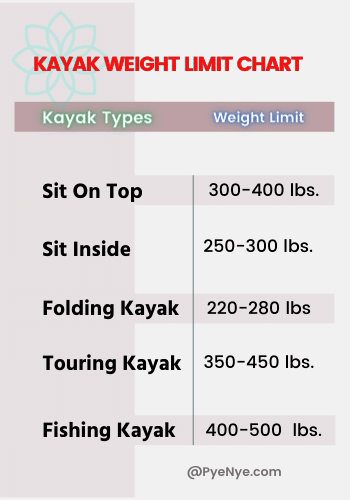It was a beautiful summer day, and Mark was ready to hit the water. He had been desiring to try out kayaking for a while but wasn’t sure which type to choose! There are different types of kayaks in the market.
Should he go for a tandem or a single kayak? It’s a difficult decision to make, especially for beginners.
That is why we’ve prepared this guide to assist you in determining a tandem vs a single kayak and which type of kayak is best for your adventure.
In this article, we’ll be presenting the ultimate comparison between a tandem kayak vs a single kayak. However, if you’re in a hurry jump to the comparison section.
Jump To A Section
An Overview Of Differences Between Tandem And Single Kayaks
The tandem kayaks are an excellent choice for touring, and family kayaking trips. Because they offer good stability, enough storage, and space that easily accommodates 2 persons. These kayaks also allow fishing, camping, and longer trips.
However, the downside is these kayaks are comparatively difficult to maneuver over single kayaks. And sometimes it might feel cumbersome when navigating tight turns or shallow waters!
The single kayak, on the other hand, was much easier to maneuver, making it better for solo paddlers. It was also more cost-effective and lighter, making transport more accessible even inside an SUV! But single kayaks are less stable than tandem kayaks.

A Brief To Tandem Kayak
Tandem kayaks are a type of kayak designed for two people. As the name implies, two people can ride in a tandem kayak at the same time, each paddling with their own set of oars. Tandem kayaks are often longer and wider than single-person kayaks, allowing them to be more stable and accommodating for two people.
Tandem kayaking is a great way to get out on the water with a friend or family member, and it can be a great way to build relationships. Not only that, but it’s a great way to get some exercise and enjoy the outdoors.
Best Use Of Tandem Kayaks
Tandem kayaks are designed to accommodate two people, so if you’re looking for a way to explore the water with a friend, this is a perfect choice.
Not only that, but many tandem kayaks also feature additional features that make them suitable for various activities. For example, some models come equipped with rod holders, making them perfect for a fishing trip with a friend. Other models feature adjustable seats, allowing you to customize the fit of your kayak to the two of you.
Like any other type of kayaking, there are both benefits and drawbacks to tandem kayaking.
Let’s take a closer look at both.
Benefits of Tandem Kayaking
The biggest advantage of tandem kayaking is that you get to share the experience with someone else. Unlike solo kayaking, where you’re the only person in the boat, tandem kayaking allows you to connect with a friend or family member as you travel down the river or explore the lake. It’s also a great way to teach someone the basics of kayaking.
Tandem kayaks are also more stable than single kayaks, as they’re wider and longer. This makes them easier to control, even if the paddlers aren’t perfectly in sync. They’re also better for longer trips, as two people can take turns paddling.
Drawbacks of Tandem Kayaking
One of the biggest drawbacks of tandem kayaking is that it takes more coordination between the two paddlers. If you’re not ideally in sync, it can be difficult to move the boat in a straight line. It can also be difficult to turn the boat if one person paddles faster or slower than the other.
Another downside is that tandem kayaks can be more expensive than single kayaks. They’re also more cumbersome, as they’re heavier and take up more space. This can make them difficult to transport! But with a little preparation, you can also carry your kayak on a motorhome.
Overall, tandem kayaking can be a great way to get out on the water with a friend or your family. It can also be a great way to exercise and enjoy the outdoors. However, it does require more coordination than solo kayaking and can be more expensive and bulky to transport.
A Brief To Single Kayak
A single kayak is a small, lightweight watercraft designed for one person to paddle. It’s generally more maneuverable than a tandem kayak and is a great choice for beginner and intermediate paddlers. Single kayaks are popular for recreational and touring purposes alike.
They can be used for fishing, kayaking on rough water, and even over a waterfall! They’re also great for paddling in small bodies of water such as ponds, lakes, and bays.
Best Use Of Single Kayaks
One of the best things about single kayaks is their versatility. They can be used for a variety of activities, from fishing to rough waters to just cruising around!
A single kayak is also great for fishing. If you’re looking for a relaxing day on the water, a single kayak is perfect for casting your line and waiting for a bite.
If you’re a beginner, you may want to start with a single recreational kayak, which is designed for leisurely paddling. Recreational kayaks are typically wide and stable, making them easy to maneuver in calm waters. They are also lightweight and easy to transport.
However, if you’re looking for a bit more of an adventure, you may want to consider a touring kayak. Touring kayaks are designed to be faster and more efficient in open waters, allowing you to paddle further distances in less time.
They are usually narrower and longer than recreational kayaks and are also often equipped with rudders or skegs for better tracking and control.
Benefits of Single Kayaking
One of the major advantages of single kayaking is that it’s much cheaper than tandem kayaking. With a single kayak, you only need to purchase one boat and one set of paddles. This makes it a great option for those on a budget who don’t necessarily want to invest in a more expensive and complex tandem kayak.
Single kayaks also tend to be more lightweight and easier to transport. This is because they are designed to be used by one person and don’t require a lot of extra gear or accessories. They can also be easily stored in a car or boat, making them an ideal choice for those who don’t have the space for a larger tandem kayak.
Single kayaks are also much easier to maneuver and control than tandem kayaks. This means that you can focus on mastering one skill at a time and build up your speed and confidence as you become more experienced!
Drawbacks of Single Kayaking
One of the main drawbacks of single kayaking is that it can be harder to stay connected to your surroundings. When kayaking alone, you don’t have another person to rely on for help. This can make it more difficult to stay oriented and stay on track, especially in unfamiliar waters.
Single kayaks also don’t offer the same level of stability as tandem kayaks. This means that you’ll have to be more cautious when navigating rough waters or navigating around obstacles.
Tandem Vs Single Kayak Comparison
When it comes to planning a kayaking expedition, the most important question you’ll have to answer is whether to take a tandem or a single kayak. Both have advantages and disadvantages, and the choice will largely depend on what type of experience you’re looking for.
Here, we’re going to compare the differences between tandem and single kayaks so you can decide which one is best for your adventure.
To start off, let’s take a look at the main differences between tandem and single kayaks. Tandem kayaks are designed to accommodate two people, while single kayaks are designed for one. Tandem kayaks offer more space, allowing two people to fit comfortably and share the workload.
They’re also more stable than single kayaks since they’re longer and heavier. On the other hand, single kayaks are smaller and more maneuverable, which can make them easier to handle in tight spaces.
When it comes to speed, single kayaks tend to be faster than tandem kayaks since they’re lighter and less affected by drag. However, tandem kayaks can be faster when paddled by two people working together.
They’re also more efficient in terms of energy output since the two paddlers can work together to move the boat more efficiently.
And when it comes to storage capacity, tandem kayaks tend to have more available storage space since they are larger. This can be useful if you’re planning a longer trip, as you can fit more gear. Single kayaks may be more compact and easier to transport, however.
Tandem Or Single Which Kayak Is Best For Your Adventure?
Deciding between a single kayak or a tandem kayak depends on your individual needs. If you plan to kayak with a friend or family member, then a tandem kayak is the best option. It will allow you to have more stability, cover more ground and even enjoy a conversation.
However, if you are looking for a reliable kayak for solo trips, then a single kayak is the way to go. It is lightweight, cheaper, and easier to store.
Let’s take a look at some of the pros and cons of each type of kayak;
| Category | Tandem Kayak | Single Kayak |
|---|---|---|
| Stability | More stable | Comparatively less stable |
| Weight | 25 – 70 lbs | 60 – 80 lbs. |
| Speed | Slower than single | Faster |
| Maneuverability | Harder to maneuver | Easier to maneuver |
| Capacity | 500 – 600 lbs | 250 – 350 lbs. |
| Transporting | Hader | Easier |
| Best Use | Recreational, and family kayaking on calm water | Solo kayaking, and paddling on rough waterways |
Factors To Consider When Choosing Between Tandem And Single Kayak
When deciding between a tandem vs a single kayak, there are many factors to consider. It’s essential to think about the type of waters you’re paddling and the amount of space you’ll need for your gear.
Here are a few factors that you need to consider when choosing between a tandem kayak and a single kayak;
Your Skill Level And Experience
The type of kayak you choose should depend on your skill level and experience. If you’re an experienced kayaker, a single kayak will provide you with more control, speed, and maneuverability. Wheres tandem kayaks are better suited for novice or beginner kayakers because they are designed to provide more stability and ease of use.
Body Size And Weight Capacity
Another important factor to consider is your body size and weight capacity. Single kayaks usually have a higher weight capacity than tandem kayaks. If you’re larger or heavier than average, a single kayak may be the best option for you.

However, if you’re smaller or lighter than average, a tandem kayak may be better suited for you because it can accommodate two people!
Available Space For Storage And Transportation
The amount of available space for storage and transportation is another factor to consider when choosing between tandem and single kayaks. Tandem kayaks are usually larger and heavier than single kayaks.
It means they may not be as easy to transport or store! If you’re limited in terms of space and/or transportation, a single kayak may be the better option. You can even carry a single kayak inside your SUV!
Related: Reviewing Top Kayak Roof Rack For SUV From The Scratch
Performance Considerations
Another factor to consider when choosing between tandem and single kayaks is performance. Single kayaks are usually faster and more maneuverable than tandem kayaks, so if you’re looking for maximum performance, then a single kayak is the way to go.
Storage Capacity Considerations
Regarding storage capacity, tandem kayaks usually have more than single kayaks. If you’re planning to bring extra gear or supplies, then a tandem kayak may be a better choice.
Passenger Capacity Considerations
If you’re planning to take a friend or family member along for the ride, then a tandem kayak is the obvious choice. However, if you’re looking for a solo experience, then a single kayak may be the best option.
Maintenance Considerations
Finally, maintenance is another important factor to consider when choosing between a tandem vs single kayak. Tandem kayaks require more maintenance than single kayaks, so if you’re looking for an option that’s easy to maintain, then a single kayak may be the best choice for you.
Budget Considerations
Of course, budget is also an important factor when choosing between the two types of kayaks. Single kayaks are usually more affordable than tandem kayaks, so if you’re looking for a more budget-friendly option, a single kayak may be the best choice for you.
To sum up, it all comes down to personal preference and what type of experience you’re looking for. If you’re planning a longer trip and want to share the workload and experience, a tandem kayak might be your best choice.
However, if you’re looking for a more agile and fast kayaking experience, a single kayak could be the right choice. Consider the pros and cons between tandem vs single kayak and point out what suits your plan.
Whichever you choose, make sure to take the time to learn the basics of kayaking and practice safety measures at all times.


